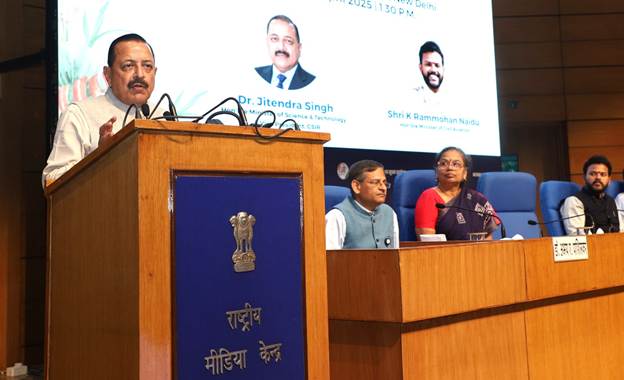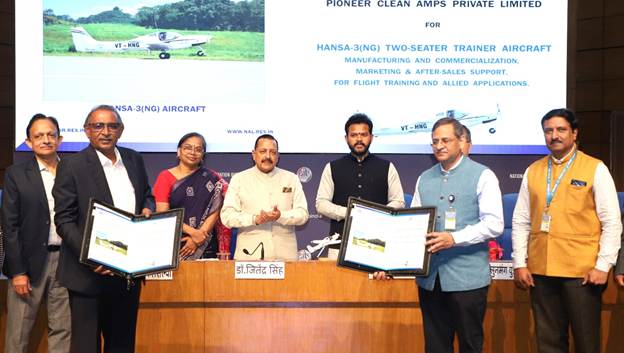Ministry of Science & Technology
CSIR’s Indigenously Designed and Developed HANSA-3(NG) Trainer Aircraft Signifies Giant Leap for Creating India’s Robust Aviation Ecosystem: Dr. Jitendra Singh
Huge Opportunity for Startups and MSMEs; Potential for Employment Generation through Indigenization of Technologies
Democratization and Decentralization of Pilot Training to Reduce Costs and Realize Youth Aspirations
Collaboration Model of Space Economy to be Replicated in Aviation Sector to Meet Growing Demand
प्रविष्टि तिथि:
04 APR 2025 4:13PM by PIB Delhi
Union Minister Dr. Jitendra Singh today officially launched indigenous "Trainer Aircraft" technology for Commercial Pilot Licensing (CPL) and also announced the decision to involve the private sector to collaborate in the manufacture of this aircraft.
At a ceremony held at National Media Centre here, the Minister formalized the Transfer of Technology (ToT) of CSIR’s indigenously designed and developed HANSA-3(NG) trainer aircraft for Commercial Pilot Licensing (CPL) at the National Media Centre, New Delhi. The licensing of the HANSA-3(NG) two-seater trainer aircraft has been granted to M/s Pioneer Clean Amps Pvt. Ltd.
Union Minister of State (Independent Charge) for Science and Technology, Minister of State (Independent Charge) for Earth Sciences, MoS PMO, Department of Atomic Energy and Department of Space, MoS Personnel, Public Grievances and Pensions, Dr. Jitendra Singh lauded the efforts of CSIR scientists for the successful demonstration and commercialization of the indigenous HANSA-3(NG), noting that the aircraft will fulfill the requirements of flying clubs in providing PPL (Private Pilot License) and CPL (Commercial Pilot License) training to the young generation.

The Minister emphasized the need to develop a large and world-class flying training ecosystem in India to meet the rapidly growing demand of the Indian aviation sector. The availability of CSIR’s indigenous HANSA-3(NG) aircraft will strengthen India’s aviation industry and help realize Prime Minister Shri Narendra Modi Ji’s vision of India becoming a leading aviation hub by the end of the decade and achieving the goal of Viksit Bharat by 2047.
Dr. Jitendra Singh highlighted the huge opportunity for StartUps and MSMEs, along with significant employment generation potential through the indigenization of aviation technologies. He emphasized that indigenous small aircraft manufacturing under the “Atmanirbhar Bharat” initiative would support the development of infrastructure and promote small & medium-scale private entrepreneurs in the production of airworthy components, including assembly and integration of aircraft in India.
He also pointed out the socio-economic potential of this initiative, which will create employment opportunities through on-the-job training for ITI & Diploma holders in various disciplines of aircraft building and Aircraft Maintenance Engineering (AME) training.
Dr. Jitendra Singh reaffirmed the government's focus on democratization and decentralization of pilot training, which will reduce the cost of pilot training and give wings to the aspirations of youth, many of whom give up on their dream of becoming pilots due to affordability issues.

He stated, “Success in Space Economy by collaborating with the private sector will now be replicated in the aviation sector to meet the growing demand.”
India will need 30,000 pilots over the next 15–20 years, up from the current 6,000–7,000 pilots, as Indian airlines collectively have over 1,700 aircraft on order. Currently, India's commercial aircraft fleet stands at over 800 aircraft. Typically, each aircraft requires 15–20 pilots for narrow-body aircraft and 25–30 pilots for long-range wide-body jets. Hence, there is an urgent need to create a world-class flying training ecosystem in the country. Dr. Singh also credited Union Minister for Civil Aviation Shri K. Ram Mohan Naidu for enabling growth in the sector.
Union Minister for Civil Aviation, Shri K. Ram Mohan Naidu, complimented CSIR and CSIR-NAL scientists for their commitment towards the commercialization of the HANSA-3(NG) aircraft, following his recent visit to CSIR-NAL in October 2024.
The HANSA-3(NG) aircraft comes equipped with a digital display (glass cockpit) system and is powered by an advanced fuel-efficient Rotax 912 iSc3 Sports engine. The aircraft features a bubble canopy with a cabin width of 43 inches and electrically operated flaps, meeting modern user requirements. It offers excellent performance with a range of 620 nautical miles, 7 hours of endurance, and a maximum cruise speed of 98 Knots Calibrated Airspeed (KCAS).
Dr. N. Kalaiselvi, Secretary, DSIR & Director General, CSIR, while congratulating the scientists, said that the successful flying demonstration of HANSA-3(NG) at Aero India 2025 reflects CSIR’s unwavering commitment to developing indigenous technologies to meet the national need. These efforts aim to serve end customers like Flying Training Organizations (FTOs), ensuring a complete ecosystem for commercialization of CSIR technologies.
Dr. Abhay Pashilkar, Director shared that CSIR-NAL has received Letters of Intent (LOI) for 110+ HANSA-3(NG) aircraft from FTOs across the country. To meet the domestic demand and export potential, CSIR-NAL has partnered with M/s Pioneer Clean Amps Pvt. Ltd., Mumbai, who will set up a manufacturing facility aiming to build 36 aircraft per year, with plans to scale up to 72 aircraft annually, in alignment with the goals of Atmanirbhar Bharat.
*****
NKR/PSM
(रिलीज़ आईडी: 2118821)
आगंतुक पटल : 2424